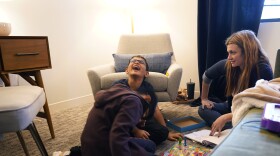Maryland health and education leaders are teaming up to spread an over 200-page suicide prevention guide to local school districts as students continue to struggle with their mental health.
The Maryland Action Plan to Prevent Suicide in Schools, called MAPS for short, went public in early September. The document outlines specific roles and duties for every school system actor, from administrators to teachers to caregivers.
“When this happens to one of your students, the prefrontal cortex shuts down,” said Michael Muempfer, director of the Maryland School Mental Health Response Program. “You're not thinking, you're reacting. It's very emotional, very frightening, very sad.”
Muempfer said that the state requires each local school district to train staff in basic skills for suicide prevention and intervention. But the materials they use vary.
So, the Maryland departments of health and education brought in outside suicide prevention experts Scott and Donna Poland to create a universal checklist to use in moments of crisis. It includes suicide risk assessments and tools for mental health providers, and scripts for teachers and principals to use when talking with students and parents.
According to the 2022-2023 Youth Risk Behavior Survey conducted by the Maryland Department of Health, one in five middle schoolers in the state made a suicide plan in 2022. Fourteen percent of LGBTQ+ youth in Maryland attempted suicide that same year.
“Unfortunately, we live in a world where the crises don't take turns; they're often happening when our resources are drained,” Muempfer said. “The statistics speak for themselves. Suicide is on the rise. It's reaching lower grade levels. I don't know if you can ever be prepared, but you can prepare.”
Sheri Koller, a licensed clinical social worker and owner of a school mental health consulting business, said she was impressed by the Maryland guide.
Koller said school staff and leaders often struggle with knowing their role in suicide prevention. And this was one of few guides she’s read that includes sections for school actors besides the mental health team — like teachers.
“They're often the first point of contact for youth, and so having them be included in this was really sending a strong message about how this is a community response, and that teachers hold a very important role in that as well,” Koller said.
She also praised the guide for including sections on using culturally-responsive terminology to meet families where they are. But she said it could use more attention to the increased risk of suicide faced by LGBTQ+ students.
“If a child has a supportive school and home and community, those actually become protective factors against suicide,” Koller said. “And so I feel like if we're talking about that with our caregivers and students, then we should also be talking about that with our staff, because not all staff participate in creating a safe and inclusive school environment.”
MAPS focuses heavily on postvention, or how to offer support in the wake of a suicide death in a way that prevents further tragedy. That’s where the detailed scripts come into play.
“The messaging and the way that [suicide] is communicated is so important, because young people especially are vulnerable to contagion, to copycat suicides,” said Holly Wilcox, a mental health professor at Johns Hopkins University. “We want to communicate it in a way that is matter of fact, like, ‘Here's the information, and here are the resources and supports that we can provide.’”
The state guide advises administrators to avoid large assemblies, and instead have conversations in small groups. It outlines the “empty chair” procedure, where a staff member follows a class schedule for the week after a suicide loss, offering continuous support.
“I think oftentimes what I've seen is that postvention is kind of separated as a completely different suicide intervention for youth,” Koller said. “And the reality is that it's all kind of one. It's multiple pieces of the same big puzzle.”
Alyssa Lord, deputy secretary for the state’s Behavioral Health Administration, said the next step is to disseminate the MAPS information to the ground-level actors.
“So we've posted the materials on our website, and then we are going to be doing training in a multitude of different settings,” she said. “We're going to be looking for feedback so that we can build out this continuum of support and be responsive to what we're hearing from our school community.”








